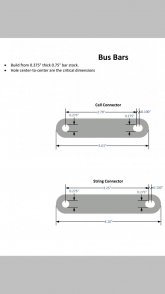Did you have any luck finding aluminum flange nuts with the norlock type flange? I found some aluminum lock washers but stopped looking.
I'm keeping it simple and going with aluminum lock washers. I sourced them from Home Depot, of all places. I went with 1/4" size, which were much more readily available than was a metric size. $.59 for a bag of five, free shipping. I ordered six bags. They'll be here before the bolts arrive.
I don't have ANY lock washers on my terminals at this time and the torque hasn't changed after a 1400 mile trip that included 10 miles of dirt road.
Bus bar stock arrived today. I ordered stock of two different thickness, .25" and .375". Both 1" wide. I thought I would experiment a bit. I was ordering other stock, so adding the thicker bar didn't add much to the order.




